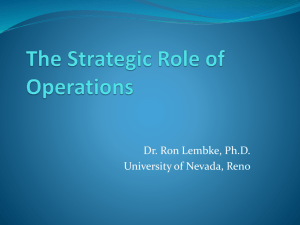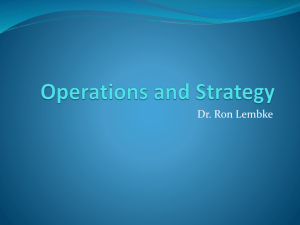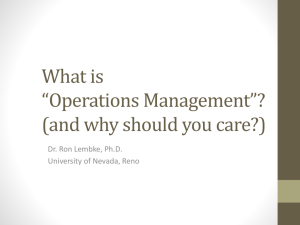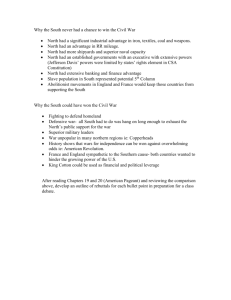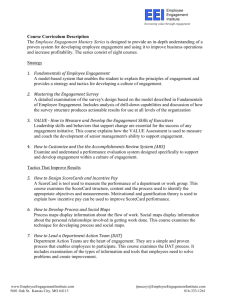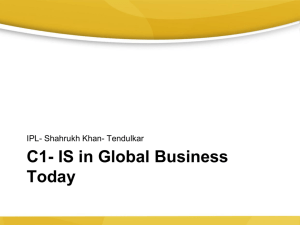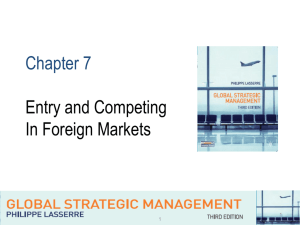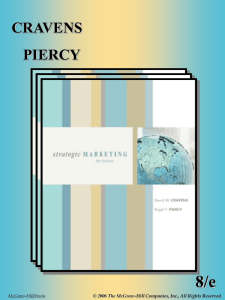Operations Management MGRS 352
advertisement
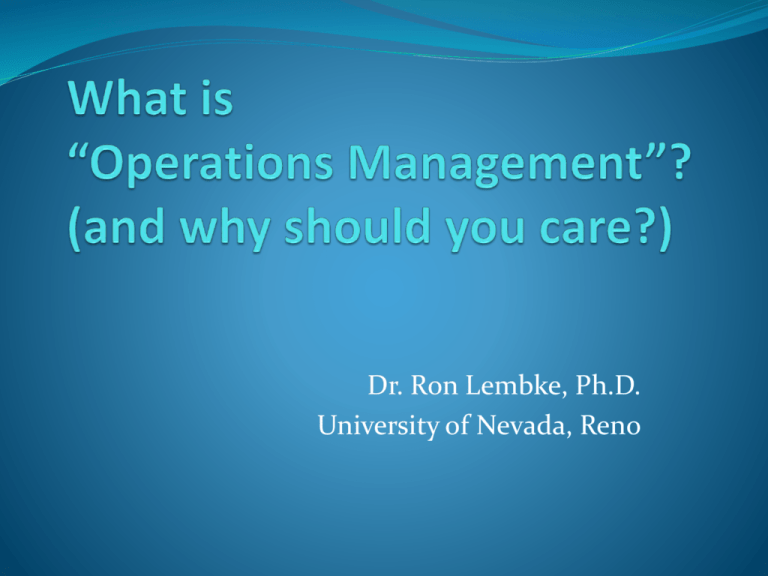
Dr. Ron Lembke, Ph.D. University of Nevada, Reno Reaching me Email: Phone: WWW: ronlembke@unr.edu (775) 682-9164 http://coba.unr.edu/faculty/ronlembke When emailing, please include “701” in the subject line. Don’t call my house, and I won’t call yours. Deal? Who Are You? (This is Homework) In an email, please tell me the following: Your name Major phone #’s to reach you at Where From Interests / Hobbies Musical interests email address when you anticipate graduating any experience you have had that might be relevant to this course The Goal What is the goal of a company? Efficent & Effective Efficiency: Doing things with the least use of resources Effectiveness: Doing the right thing at the right time. Value = Quality / $ What is Operations Management? “The design, operation, and improvement of the systems that create and deliver the firm’s primary products and services.” p. 6. Operations research / management science Applying quantitative methods to decision making Industrial Engineering Engineering discipline OM is a field of management that may use some tools from OR/MS and IE. What is OM? Manage entire system for delivering service or product for OEM Original Equipment Manufacturer Brand name on the product. Probably doesn’t produce Suppliers, vendors, Third party logistics providers (3PLs) Contract manufacturers – Solectron, Flextronics Why OM is the most important area Marketing gets people to buy our product Finance makes sure we have the money to operate Accounting keeps track of what we spend Management keeps people on task I/S makes sure systems work to support everyone else Operations actually makes the thing we sell. Without operations, you can’t have a company. Why Do You Care? Satisfying Customers depends on Operations You must understand and work in or with Operations: Finance: Depr, Cash Flow, Make vs. Buy Acctg: Cost estimates, Overhead, Inv valuation Mktg: What can be done? HR: job descr, standards, incentives MIS: production, shipping, billing, receiving Operations as Service Everybody’s in service Core services: done correctly, customized to their needs, delivered on time, priced competitively Value-added services: make life easier, help do jobs easier: Information on product – data, specs Problem solving – help internal, external customer Sales support – demo product trying to sell Field support – replace parts quickly Decisions of OM 1. Quality: what do customers want? 2. Goods & Service Design: what to sell? 3. Process & Capacity Design: how to make it and how much capacity to have? When add more? Where? How? 4. Location Selection: where to build? 5. Layout Design: how to design facilities? Decisions of OM 6. Human Resource & Job Design: what skills and how many people needed? 7. Supply chain management: vendor management, who use as suppliers? 8. Inventory: how much and where? 9. Scheduling: HR, facility needs, when? 10. Maintenance: how much, when? Current OM Issues Flexible supply chains for mass customization of products and services Global supplier, production, and distribution networks Commoditization of suppliers – “plug compatibility” Enhancing value-added services Maximizing use of internet to share information, coordinate production Continuous Process Improvement It used to be you had to be “good enough” Now, you must be looking for ways to make your customer happy, and meet their future needs If you aren’t someone else is, and is going to take your business What is strategy? How a firm intends to create and sustain value for its shareholders (p. 24) Major components: Operations effectiveness Customer management Product innovation Competitiveness: A firm’s relative position in comparison to other firms in the marketplace Satisfying the Customer Mission: the organization’s purpose, what it hopes to achieve; rationale for its existence. To provide society with superior products and services-innovations and solutions that improve the quality of life and satisfy customer needs--to provide employees with meaningful work and advancement opportunities and investors with a superior rate of return. (Merck mission statement) Mission Statement “Without a clear mission, an organization is unlikely to achieve its true potential, because there is little direction for formulating strategies.” Wouldn’t the same be true about people? My Favorite Guru When you think of something, put it on a list. Check your lists regularly. Don’t get sucked into email distractions. Get rid of the clutter you don’t need. Strategy Strategy: a plan for achieving the mission Each functional area (accounting, finance, marketing) determines its “supporting mission” Tactics: the methods to be used to achieve the strategic goals. Must support mission, corporate values Michael Porter Three ways to achieve corporate mission: 1. Differentiation: Make your product different and / or better 2. Cost Leadership (lower prices): Wal- Mart, Southwest Airlines 3. Quick Response: Pizza Hut, FedEx Purchasing Triangle Quality Price Speed “Don’t be sad; two out of three ain’t bad” -- Meatloaf Competitive Dimensions Cost -- make it cheap Quality and Reliability -- make it good Speed -- make it fast Reliability -- deliver when promised Cope with Change -- change volume New product speed Customer support Focus What is Merck’s strategy? To provide society with superior products and services--innovations and solutions that improve the quality of life and satisfy customer needs--to provide employees with meaningful work and advancement opportunities and investors with a superior rate of return. Impact of Life Cycle iTunes CDs DVD Audio Cassettes Records MiniDisc DAT 8-Tracks Introduction Growth Maturity Decline Impact of Life Cycle Records DAT Introduction Growth Maturity Decline Impact of Life Cycle Introduction: develop product, small-scale production Growth: ramp up production, marketing Maturity: standardized, volume production, optimization Decline: cost minimization, eliminate unprofitable products Competitiveness Order qualifiers: screening criterion that allows your products to be considered deliver on-time, reliability, general quality Order Winners: criterion that differentiates your service/product above the competition price, quality, reliability Balanced Scorecard – track performance from following perspectives: Financial: revenue or productivity growth Customer: Product leadership, customer intimacy, operational excellence Internal: innovation, customer management, operational excellence, corporate citizenship Learning and Growth: strategic competencies and technologies, climate for action Kaplan and Martin, 1992, “The Balanced Scorecard: Measures that Drive Performance” Harvard Business Review Operations Strategy Core capabilities: the skills that differentiate the firm from its competitors. What is the thing you do better than everyone else, that you could never dare trust to anyone else? Soft drinks: the secret sauce Automobiles: designing engines Productivity Productivity = Outputs / Inputs Partial: Output/Labor or Output/Capital Multifactor: Output / (Labor + Capital + Energy ) Total Measure: Output / Inputs Productivity Services have always been a large portion of U.S. economy Services’ share continues to grow U.S. has higher service % than others U.S. productivity growth has lagged other countries in past. What explains this phenomena? Improving Productivity Develop productivity measurements– you can’t improve what you can’t measure Identify and Improve bottleneck operations first Establish goals, document and publicize improvements
